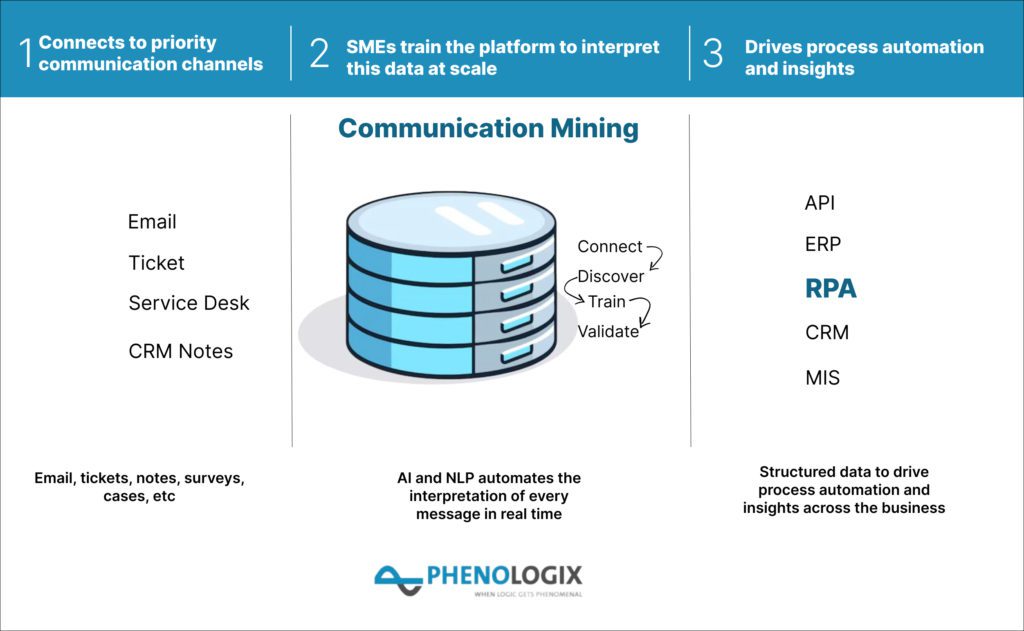Communication Mining: Empowering Data into Actionable Intelligence and Break Charts
Communication Mining: Empowering Data into Actionable Intelligence and Break Charts
Introduction to Communication Mining:
In today’s data-driven world, communication mining has emerged as a powerful tool for extracting valuable insights from the vast amounts of unstructured data generated by various communication channels. Unlike traditional data mining, which focuses on structured data, communication mining delves into emails, chat logs, call transcripts, and other forms of communication to uncover patterns and trends that can significantly impact business operations. This blog post aims to explore the concept of communication mining, its importance in the IT sector, and the key technologies that make it possible.
What is Communication Mining?
Communication mining refers to the process of analyzing unstructured communication data to derive meaningful insights. This can include anything from understanding customer sentiment in emails to identifying key discussion points in team chat logs. The primary goal is to convert the rich, qualitative data found in communications into quantitative, actionable intelligence that can guide business decisions.
Differences Between Communication Mining and Traditional Data Mining
While both communication mining and traditional data mining aim to extract valuable information from data, they differ significantly in their approach and the type of data they handle. Traditional data mining focuses on structured data—well-organized information stored in databases, such as sales figures, inventory levels, and customer demographics. It uses statistical methods and machine learning algorithms to find patterns and correlations within this data.
In contrast, communication mining deals with unstructured data—free-form text that doesn’t fit neatly into databases. This includes emails, chat messages, and call transcripts. Extracting insights from this type of data requires advanced techniques like Natural Language Processing (NLP) and machine learning. These technologies enable the identification of sentiment, key phrases, and even contextual meaning from large volumes of text.
Key Technologies and Methodologies Involved
The backbone of communication mining is NLP, a branch of artificial intelligence that focuses on the interaction between computers and human language. NLP techniques, such as tokenization, sentiment analysis, and entity recognition, are used to break down and analyze text data. Machine learning algorithms further enhance this process by identifying patterns and making predictions based on the analyzed data.
Other essential technologies include speech recognition for analyzing voice communications and data visualization tools to present the findings in an accessible and actionable format. Together, these technologies transform raw communication data into valuable insights that can drive business improvement and innovation.

In the IT sector, communication mining is particularly important for enhancing decision-making processes, improving customer support, and streamlining internal workflows. By leveraging these insights, companies can better understand their customers, optimize their operations, and stay ahead in the competitive landscape.
Importance of Communication Mining in IT
In the IT sector, communication mining is a game-changer, offering profound insights that drive strategic and operational excellence. This process involves extracting valuable information from various communication channels, such as emails, chat logs, and call transcripts, to enhance decision-making, improve customer support, and streamline internal workflows.
Enhancing Decision-Making Processes
Effective decision-making in IT relies heavily on accurate and timely information. Communication mining enables organizations to analyze vast amounts of unstructured communication data, identifying trends and patterns that inform critical business decisions. By leveraging natural language processing (NLP) and machine learning (ML) algorithms, IT leaders can gain insights into employee sentiments, customer feedback, and market dynamics. This data-driven approach allows for more informed decisions, reducing the risk of errors and enhancing the overall strategic direction of the company.
Improving Customer Support and Service
Customer support is a vital area where communication mining demonstrates significant benefits. By analyzing customer interactions across various platforms, IT departments can identify common issues, customer pain points, and areas for service improvement. This enables the creation of more effective support strategies, enhancing the customer experience. Additionally, communication mining can improve the performance of chatbots and virtual assistants by providing them with more relevant and contextual information, leading to quicker and more accurate responses to customer inquiries. The result is a more responsive and efficient customer support system that fosters greater customer satisfaction and loyalty.
Streamlining Internal Communications and Workflows
Internal communications and workflows are crucial for maintaining productivity and efficiency in IT operations. Communication mining helps in monitoring and analyzing internal communications to identify bottlenecks, misunderstandings, and areas where processes can be optimized. By providing insights into how teams interact and collaborate, organizations can streamline workflows, reduce redundancies, and enhance overall productivity. This leads to a more cohesive work environment where employees can communicate more effectively, collaborate on projects seamlessly, and achieve their objectives more efficiently.
In summary, communication mining is essential for IT organizations seeking to enhance decision-making, improve customer support, and streamline internal communications. By leveraging this technology, companies can unlock valuable insights that drive growth, efficiency, and customer satisfaction.
Application of Communication Mining
Communication mining offers diverse applications across various sectors, particularly in customer service, employee productivity, and security compliance. By extracting valuable insights from communication data, businesses can significantly enhance their operations.
Customer Service and Support Analytics
Communication mining enables organizations to analyze customer interactions across multiple channels, such as emails, chats, and calls. By scrutinizing these interactions, businesses can identify common issues, gauge customer sentiment, and uncover trends. This data-driven approach allows companies to improve their customer service strategies, leading to higher customer satisfaction and retention rates.
Analyzing Customer Feedback
Through communication mining, businesses can systematically analyze customer feedback to understand their needs and preferences better. By examining reviews, surveys, and direct communications, companies can identify areas for improvement and innovate their products or services accordingly.
Enhancing Chatbot and Virtual Assistant Capabilities
Communication mining enhances the capabilities of chatbots and virtual assistants by providing them with more accurate and contextually relevant responses. By learning from past interactions, these AI-driven tools can handle complex queries more effectively, leading to improved customer experiences.
Employee Productivity and Collaboration
Communication mining is a powerful tool for boosting employee productivity and fostering collaboration. By analyzing internal communications, such as emails and chat logs, businesses can identify workflow bottlenecks and areas where employees may need additional support or training.

Monitoring Internal Communications
Monitoring internal communications helps organizations ensure that information flows smoothly across departments. It enables the identification of miscommunications or gaps that could hinder productivity, allowing for timely interventions.
Identifying Workflow Bottlenecks
By mapping communication patterns, businesses can spot inefficiencies in workflows. This insight allows for process optimization, ensuring that tasks are completed more efficiently and effectively.
Security and Compliance
Communication mining plays a crucial role in maintaining security and compliance within an organization. By continuously monitoring communications, businesses can detect and address potential security threats and ensure adherence to regulatory standards.
Detecting Sensitive Information Leakage
Communication mining tools can identify and flag sensitive information that may be at risk of leaking. This proactive approach helps in mitigating data breaches and protecting confidential information.
Ensuring Regulatory Compliance
Maintaining regulatory compliance is critical for any organization. Communication mining helps by ensuring that all communications adhere to relevant regulations and standards, thereby avoiding legal complications and fines.
In summary, communication mining provides invaluable insights that enhance customer service, improve employee productivity, and ensure security and compliance, making it an indispensable tool for modern businesses.
How Communication Mining Works
Data Collection Methods Communication mining begins with collecting data from various sources such as emails, chat logs, and call transcripts. These sources contain rich, unstructured data that provide valuable insights into customer interactions, employee communication patterns, and operational workflows. Advanced tools can aggregate and preprocess this data, preparing it for detailed analysis.
Natural Language Processing (NLP) and Machine Learning (ML) Techniques Once the data is collected, NLP and ML techniques are employed to extract meaningful information. NLP algorithms process and analyze human language, enabling the identification of sentiments, topics, and key phrases. Machine learning models then classify and predict trends based on this processed data. Techniques such as sentiment analysis, topic modeling, and entity recognition play crucial roles in understanding and interpreting the vast amounts of communication data.
Data Analysis and Visualization Tools After processing the data, advanced data analysis and visualization tools come into play. These tools transform raw data into comprehensible visual formats like graphs, charts, and dashboards. They allow stakeholders to easily interpret the results, identify patterns, and make data-driven decisions. Visualization tools help in tracking communication trends over time, pinpointing issues, and uncovering opportunities for improvement.
Challenges in Communication Mining
Data Privacy and Security Concerns One of the primary challenges in communication mining is ensuring data privacy and security. Sensitive information must be protected to comply with legal standards and maintain customer trust. Implementing robust encryption and access control mechanisms is essential to safeguard data during collection, processing, and storage.
Handling Unstructured Data Communication data is inherently unstructured, posing a significant challenge. Unlike structured data, it lacks a predefined format, making it difficult to analyze. Advanced NLP and ML techniques are required to interpret and organize this data effectively.
Ensuring Accuracy and Relevance of Insights Another challenge is ensuring the accuracy and relevance of the insights derived from communication mining. The models and algorithms must be continuously refined and updated to maintain high accuracy levels. Regularly validating and cross-checking insights against real-world outcomes is crucial to ensure their reliability and usefulness.
By overcoming these challenges, communication mining can unlock significant value, providing actionable insights that enhance decision-making, improve customer service, and streamline operations.
Throughout this exploration of Robotic Process Automation (RPA), we’ve illuminated how it acts as a keystone in modern business strategy, driving efficiencies, and innovation across various sectors. The comprehensive overview spanning from its mechanisms, benefits, practical applications, and best practices, underlines the transformative potential of RPA. By automating repetitive tasks, this technology not only streamlines operations but also propels businesses towards achieving unprecedented accuracy, cost savings, and operational excellence. The integration of RPA within the fabric of organizational processes signifies a leap towards embracing digital transformation, reinforcing the critical role it plays in fostering a competitive edge in today’s fast-paced business environment.
Looking ahead, as businesses continue to navigate the intricacies of digital transformation, the adoption and sophistication of RPA will undoubtedly escalate. This journey, underscored by our discussions on implementing RPA and overcoming associated challenges, opens avenues for further innovation and efficiency within industries.
In light of the emerging trends towards integrating AI and machine learning with RPA, the future promises even greater automation capabilities. Therefore, embracing RPA not only serves as a catalyst for immediate operational improvement but also paves the way for harnessing future technological advancements. As we conclude, the pivotal role of RPA in shaping the future of business becomes ever more apparent, underscoring its significance as an indispensable tool in the quest for efficiency, innovation, and growth.
Case Studies and Examples
Success Stories from Companies Using Communication Mining
Several companies have successfully harnessed the power of communication mining to revolutionize their operations. For instance, a leading e-commerce company utilized communication mining to analyze customer service interactions. By examining chat logs and email correspondence, they identified recurring issues and streamlined their support processes, resulting in a 20% reduction in resolution time and a significant boost in customer satisfaction.
Another example is a global financial services firm that implemented communication mining to monitor internal communications. This enabled them to detect early signs of compliance issues and potential fraud, leading to enhanced regulatory adherence and a more secure environment for their clients.
Real-World Applications and Their Impact
Communication mining has numerous real-world applications with substantial impacts. In healthcare, it aids in analyzing patient feedback and communication patterns, helping providers improve service delivery and patient outcomes. In marketing, it helps companies understand customer sentiment and preferences, driving more effective campaigns and product developments.
In the tech industry, companies use communication mining to optimize team collaboration. By analyzing project-related communications, they can identify bottlenecks and improve workflow efficiency. This leads to faster project completions and a more productive workforce.
Best Practices for Implementing Communication Mining
Choosing the Right Tools and Technologies
Implementing communication mining requires selecting appropriate tools and technologies. Companies should look for solutions that offer robust natural language processing (NLP) capabilities, scalability, and ease of integration with existing systems. Popular tools include software platforms like MonkeyLearn, RapidMiner, and custom AI solutions tailored to specific needs.
Ensuring Data Privacy and Compliance
Given the sensitive nature of communication data, ensuring privacy and compliance is paramount. Companies must implement stringent data protection measures, such as encryption and access controls, and comply with relevant regulations like GDPR and CCPA. Regular audits and updates to privacy policies are essential to maintain trust and legal compliance.
Continuous Monitoring and Improvement
Communication mining is not a one-time effort. Continuous monitoring and improvement are crucial for sustained success. Companies should regularly update their algorithms and models to adapt to changing communication patterns and business needs. Additionally, gathering feedback from users and stakeholders can provide insights for refining the system, ensuring it continues to deliver valuable and accurate insights.
By following these best practices and learning from successful case studies, companies can effectively leverage communication mining to gain actionable intelligence and drive significant improvements in their operations.
4o
Future Trends in Communication Mining
Advancements in AI and ML
The future of communication mining is being shaped by significant advancements in artificial intelligence (AI) and machine learning (ML). These technologies are enhancing the ability to process and analyze vast amounts of unstructured communication data with greater accuracy and speed. Improved NLP models are making it easier to understand context, sentiment, and intent within communications, enabling more nuanced insights. Deep learning techniques are also being leveraged to identify complex patterns and trends that were previously undetectable, further refining the quality of the insights gained.
Increasing Integration with Other Business Intelligence Tools
Another trend is the growing integration of communication mining with other business intelligence (BI) tools. This convergence allows for a more holistic view of organizational data, combining insights from communication mining with structured data from traditional BI systems. Such integration facilitates comprehensive analytics, where communication insights can directly inform business strategies, improve customer relationship management (CRM), and optimize operational efficiencies. Enhanced dashboards and visualization tools are making it easier for businesses to interpret and act on the combined data.
Emerging Applications and Possibilities
The applications of communication mining are expanding rapidly. In customer service, communication mining is being used to predict customer needs and personalize interactions. In HR, it helps in understanding employee sentiment and improving engagement. There are also emerging applications in fraud detection and risk management, where analyzing communication patterns can identify suspicious activities. Furthermore, as remote work becomes more prevalent, communication mining is essential for monitoring and improving virtual collaboration.
Conclusion
Communication mining is revolutionizing the way businesses leverage their unstructured data. It transforms communication into actionable insights, enhancing decision-making, customer support, productivity, and compliance. As AI and ML technologies advance and integration with BI tools increases, the potential of communication mining will continue to grow, offering new applications and possibilities. Businesses are encouraged to explore communication mining solutions to stay competitive and capitalize on the rich insights hidden within their communication data. Embracing these trends can lead to more informed strategies and a significant competitive edge.
4o


